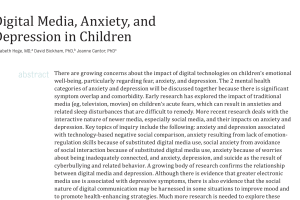Abstract
There are growing concerns about the impact of digital technologies on children’s emotional well-being, particularly regarding fear, anxiety, and depression. The 2 mental health categories of anxiety and depression will be discussed together because there is significant symptom overlap and comorbidity. Early research has explored the impact of traditional media (eg, television, movies) on children’s acute fears, which can result in anxieties and related sleep disturbances that are difficult to remedy. More recent research deals with the interactive nature of newer media, especially social media, and their impacts on anxiety and depression. Key topics of inquiry include the following: anxiety and depression associated with technology-based negative social comparison, anxiety resulting from lack of emotionregulation skills because of substituted digital media use, social anxiety from avoidance of social interaction because of substituted digital media use, anxiety because of worries about being inadequately connected, and anxiety, depression, and suicide as the result of cyberbullying and related behavior. A growing body of research confirms the relationship between digital media and depression. Although there is evidence that greater electronic media use is associated with depressive symptoms, there is also evidence that the social nature of digital communication may be harnessed in some situations to improve mood and to promote health-enhancing strategies. Much more research is needed to explore these possibilities.
This article was published in a special 2017 supplement of Pediatrics, a journal of the American Academy of Pediatrics. The supplement, “Children, Adolescents and Screens: What We Know and What We Need To Learn,” was produced by Children and Screens and includes the contributions of more than 130 interdisciplinary authors across 22 papers. See a complete list of articles included in the supplement.
